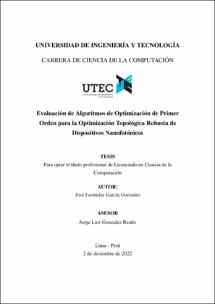Evaluación de algoritmos de optimización de primer orden para la optimización topológica robusta de dispositivos nanofotónicos
Resumen
La fotónica en silicio es un área en desarrollo emergente y constante en las últimas décadas. Los dispositivos fotónicos muestran potencial de aplicación para mejorar los sistemas de cómputo, telecomunicaciones y otras áreas. Sin embargo, aún es un reto integrar una gran cantidad de dispositivos fotónicos fundamentales en un chip con área reducida y baja pérdida. En el presente trabajo se diseñaron dos dispositivos fundamentales: (i) bend y (ii) 2-channel wavelength-demultiplexer (WDM). Los diseños se realizaron en un área de 2µm × 2µm siguiendo una estrategia basada en optimización topológica robusta. Realizamos la evaluación y comparativa de cinco algoritmos de optimización de primer orden: (i) Limited-memory Broyden–Fletcher–Goldfarb–Shanno with boundaries (L-BFGS-B), (ii) Method of Moving asymptotes (MMA), (iii) Covariance Matrix Adapatation Evolution Strategy (G-CMA-ES), (iv) Gradient Particle Swarm Optimization (GPSO) y (v) Gradient Genetic Algorithm (G-GA). Los últimos tres algoritmos son variaciones propuestas a sus versiones más populares (CMA-ES, PSO y GA) donde se incluye el cálculo de la gradiente para guiar su proceso de optimización. En nuestros resultados los diseños mejor optimizados presentan: (i) transmitancias mayores al 90 % y robustez ante errores de fabricación de dilatación y erosión, (ii) porcentaje de gris menor al 2 % y (iii) desempeño consistente y con cambios suaves en un rango de longitudes de onda (1500-1600 nm bend y 1250-1600 nm WDM) incluso si se eliminan sus regiones no conexas. Estos resultados son prometedores para (i) la integración de dispositivos WDM en un área menor al reportado en el estado del arte (<2.8µm × 2.8µm) y (ii) el diseño de bends con menores pérdidas que el diseño intuitivo-tradicional de 1µm de radio. Silicon photonics is an emerging area with constant growth in the last decades. Photonic devices show potential applications to improve computing systems, telecommunications and other areas. Nevertheless, it is still a challenge to integrate a great number of fundamental photonic devices in a chip with small area and low loss. In this work we designed two fundamental photonic devices: (i) bend and (ii) 2-channel wavelengthdemultiplexer (WDM). The designs were done on a 2µm × 2µm area following a robust topology optimization based strategy. We evaluated and comparated five first-order optimization algorithms: (i) Limitedmemory Broyden–Fletcher–Goldfarb–Shanno with boundaries (L-BFGS-B), (ii) Method of Moving asymptotes (MMA), (iii) Covariance Matrix Adapatation Evolution Strategy (G-CMA-ES), (iv) Gradient Particle Swarm Optimization (G-PSO) and (v) Gradient Genetic Algorithm (G-GA). The last three algorithms are variations of their more standard versions (CMA-ES, PSO and GA) where the computation of the gradient is included to guide the optimization process. The best optimized designs show: (i) transmission greater than 90 % and robustness to over/under-etching, (ii) a gray percentage of less than 2 % and (iii) their performance is broadband consistent with smooth changes (1500-1600 nm bend and 1250-1600 nm WDM) even after deleting non-convex regions. These results are promising for (i) the integration of WDM devices in an lower area than state of the art (<2.8µm × 2.8µm) and (ii) the design of bends with lower los than intuitive-traditional designs of 1µm radius.


